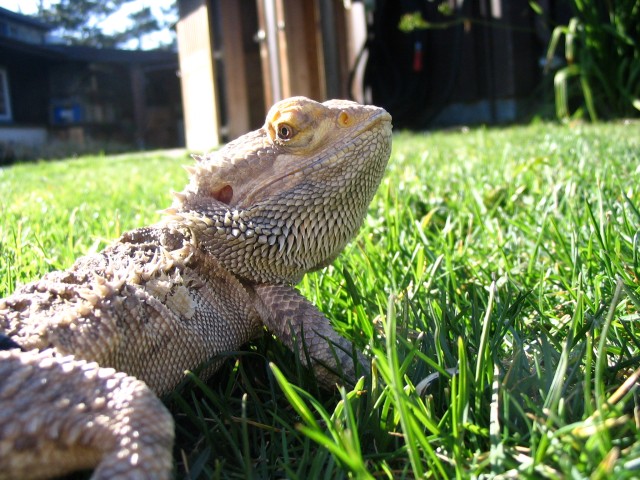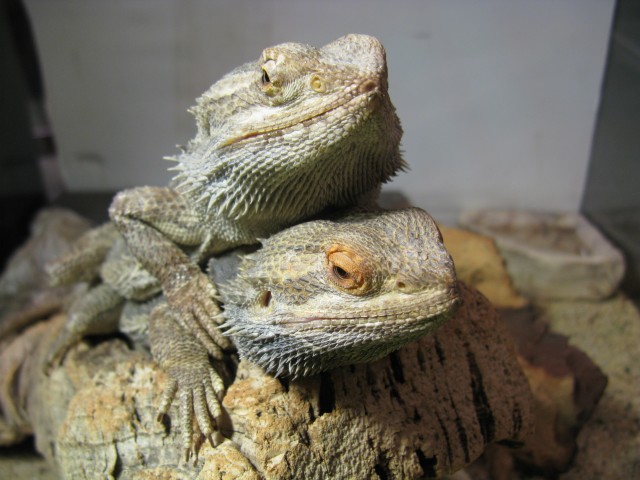These friendly little lizards have an awesome temperament. It’s rare that I would recommend a herp as a pet, but if you can take care of them these lovely lizards are really fun to just hang out with, hence the title, lounge lizards.
This particular lizard shown above is Duke and he was the most awesome-est bearded dragon ever. My most memorable moment with him was when I was holding him for an “open house” at the San Francisco Zoo and he suddenly started to get squirmy, which was unusual for him. The guitarist from Green Day was enjoying our open house and he and some other folks came up to touch Duke and that was when Duke pooped in my hand. He did try to warn me first. Duke passed away not too long ago, and I really miss him. So this post is dedicated to my lost lizard friend, Duke.
Like many animals, bearded dragons have a plethora of ways to protect themselves from predators. The first is of course camouflage. Their coloration helps them to blend in, but it is also worth noting that their color changes for various reasons, including temperature control, as they get darker when they need to absorb more heat and lighter when they need to reflect heat. (And here we are wasting precious calories making our own heat! Ha!) If a beardie is spotted, the next thing it’ll do is try to intimidate a potential predator by puffing out the extra skin around its throat to make a big black beard and to make their soft spikes stick up to look sharp and threatening. If the predator is not fooled, the lizard still won’t give up- instead it’ll high-tail it out of there by getting up on its two hind legs and running. And last but not least, if the predator should catch the lizard by its tail, it can drop its tail and the nerve endings in the tail will make it twitch and hopefully keep the predator distracted while the rest of the lizard makes its getaway. This last defense though is a one time only tactic, as they don’t regenerate their tails like some other lizards will.
I also think its cool that bearded dragons communicate with each other using different gestures. If two bearded dragons are cruising along and they run into each other, one way they might say “hello, I’m the same species as you” is to walk up and lick each other. They will sometimes wave one arm in big circles as well, which might also serve as a sign of submission. They are not usually aggressive towards each other (although they can have “ritualistic sparring matches.”) and so they can sometimes be housed together, allowing me to have the opportunity to take adorable pictures of them, like these:





Hi
Your beardies are really adorable! It’s sad that Duke past away. He sounded like an awesome bearded dragon.
I’ve was doing research into bearded dragons when I found this site and so far I’ve found them to be the most fascinating reptiles I’ve come across. Their behaviors are particularly amusing, especially the arm waving.
The way they control their temperature by changing their color is really quite spectacular too. There’s so many reasons why they make great pets. I’ve found out that they’re not that hard to keep if you know how to do it correctly. I found this site that was particularly helpful. It was http://www.beardeddragonanswers.com . This is where I discovered that they regulate their body temperature by moving in and out of the heat and that they eat all sorts of vegetables, fruits and insects.
So after all my research I found it exciting to hear of someone else who enjoys looking after them also.
Thank you for the story of Duke and the pictures of Tully and Derby. Very much appreciated!
HI .
WE HAVE A LITTLE BEARDED DRAGON NAMED CHARLIE. HE DOESNT EAT MUCH AND THAT IS A CONCERN FOR US. WE HAVE EVERYTHING THAT WE NEED FOR HIS DIET BUT HE DOESNT EVEN BOHER TO GO TO CATCH HIS FOOD. WHEN WE TRY TO FEED HIM WITH A DROPPER HE PRETENDS TO BE DEAD AND IT TAKES HIM A WHILE TO COME BACK. IT IS VERY STRESSFUL.
WHAT WOULD YOU ADVISE WE DO TO AMKE HIM FAT AND STRONG.PLEASE HELP US. THANKYOU A. KALAN